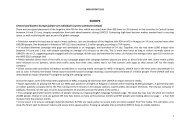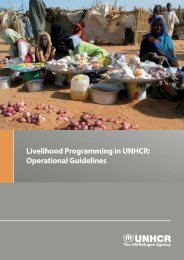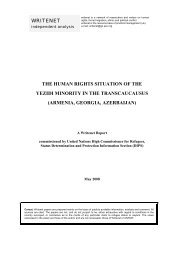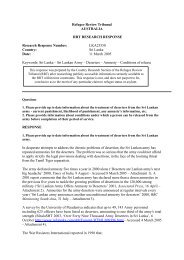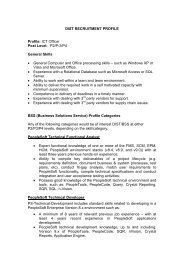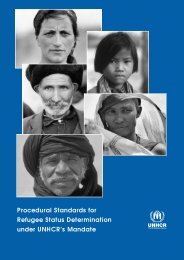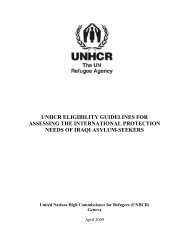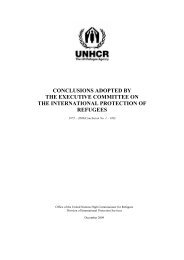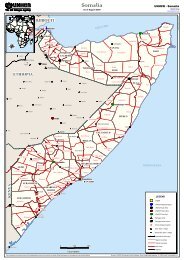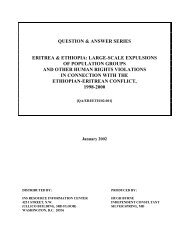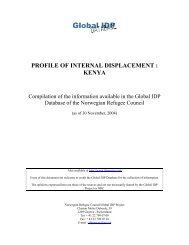UNHCR's ELIGIBILITY GUIDELINES FOR ASSESSING THE ...
UNHCR's ELIGIBILITY GUIDELINES FOR ASSESSING THE ...
UNHCR's ELIGIBILITY GUIDELINES FOR ASSESSING THE ...
Create successful ePaper yourself
Turn your PDF publications into a flip-book with our unique Google optimized e-Paper software.
“Sunni triangle”. Around half of them live in urban areas, mainly in Baghdad and Mosul,<br />
while the Shi’ites dominate the areas south of Baghdad as well as a large portion of<br />
Baghdad, in particular Sadr City. 149<br />
The contemporary divide between Shi’ites and Sunnis in Iraq, however, includes more than<br />
the above-described schism. In fact, there has been considerable intermarriage between the<br />
two groups among the urban middle class and some Iraqi tribes have both Sunni and Shi’ite<br />
branches. 150 In reality, the schism is also a result of the politics of the former regimes,<br />
exacerbated by post-2003 emphasis on religious and ethnic identities. 151 Despite the fact<br />
that, since its formation in 1921, Iraq has been largely secular, Sunni Arabs by-and-large<br />
dominated the country’s government, military and economy. The Ba’athist Government of<br />
Saddam Hussein targeted the Shi’a clergy and the Shi’ite population at large. According to<br />
Global Security,<br />
“Forces from the Intelligence Service (Mukhabarat), General Security (Amn al-Amm), the<br />
Military Bureau, Saddam’s Commandos (Fedayeen Saddam), and the Ba’ath Party […]<br />
killed senior Shi’a clerics, desecrated Shi’a mosques and holy sites (particularly in the<br />
aftermath of the 1991 civil uprising), arrested tens of thousands of Shi’a, interfered with<br />
Shi’a religious education, prevented Shi’a adherents from performing their religious rites,<br />
and fired upon or arrested Shi’a who sought to take part in their religious processions.<br />
Security agents reportedly are stationed at all the major Shi’a mosques and shrines, and<br />
search, harass, and arbitrarily arrest worshipers.” 152<br />
Furthermore, the regime of Saddam Hussein was responsible for military campaigns against<br />
Shi’ite civilians, extra-judicial killings, the confiscation of land and the drainage of the<br />
Southern marsh areas and forcible relocation of its original inhabitants, the Marsh Arabs.<br />
The unequal distribution of the country’s resources led to the under-development of the<br />
mainly Shi’ite South of Iraq. 153<br />
ii) The Emergence of the Current Sectarian Violence<br />
The Sunni-driven insurgency initially targeted US troops. Soon, with the involvement of<br />
Al-Qa’eda in Iraq, parts of the insurgency deliberately attacked Shi’a targets. Igniting<br />
sectarian violence is central to Al-Qa’eda’s strategy in Iraq. In a 15 June 2004 letter<br />
purportedly authored by Abu Musab Al-Zarqawi, Al-Qa’eda’s former leader, and addressed<br />
149<br />
Global Security, Sunni Islam in Iraq, http://www.globalsecurity.org/military/world/iraq/religionsunni.htm<br />
[last updated 22 June 2005].<br />
150<br />
CFR, Iraq: The Sunnis, see above footnote 148.<br />
151<br />
According to the ICG, Iraq’s electoral law, drafted in 2004, had also furthered “communalism” and<br />
“deepened ethnic and sectarian identities (…)”; see ICG, After Baker-Hamilton, p. 19, see above footnote<br />
111. The USIP assessed that “(i)n order to gain power in a political vacuum, among an electorate with few<br />
institutions and little experience, leaders appealed to ethnic and sectarian identity with great success,<br />
mobilizing these sentiments and organizing coalitions on this basis, and thus furthering the division of Iraq<br />
largely along ethnic and sectarian lines”; Phebe Marr, Iraq’s New Political Map, USIP, Special Report,<br />
January 2007, p. 7, http://www.usip.org/pubs/specialreports/sr179.pdf.<br />
152<br />
Global Security, Sunni Islam in Iraq, see above footnote 149. However, the Ba’athist regime of former<br />
President Saddam Hussein exploited religion to mobilize his people, in particular during the Iraq-Iran War in<br />
the 1980s. See: Global Security, Shia-Baath Relations, http://www.globalsecurity.org/military/world/iraq/<br />
religion-shia-baath.htm [last updated 22 June 2005].<br />
153<br />
Global Security, Shia-Baath Relations, see above footnote 152.<br />
48




